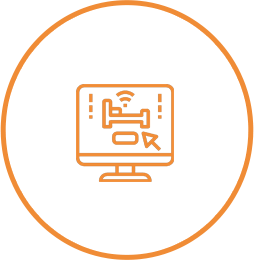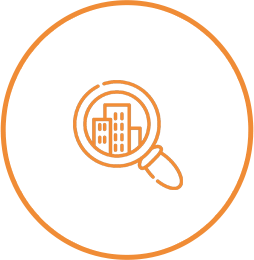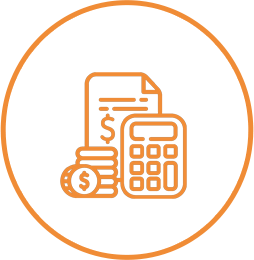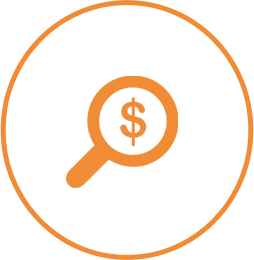Revenue management can be defined as the strategic distribution and pricing tactics used to sell a property’s perishable inventory to the right guests at the right time, to boost overall revenue growth.
Table of contents
- Introduction to Hotel Revenue Management
- What is Hotel Revenue Management?
- Hotel Revenue Management Acronyms: What do they mean?
- Guest segmentation in revenue management
- Understand the basics of Revenue Management
- Yield Management
- Common mistakes to avoid
- Most profitable channel to consider while selling your rooms
Introduction To Hotel Revenue Management
Hotel Revenue management kicked off with the airline industry in the 1980s. By mid 1990s, it crept into the hospitality industry. And before we knew, it has become integral for accommodation providers of all shapes, sizes and types.
As a hotel revenue manager, you need to analyse, forecast and optimise inventory through rates and restrictions creating demand instead of just satisfying what comes in with season and environment.
So, how do everyday hoteliers, general managers and marketing staff wrap their heads around the technical, complex world of revenue management?
By understanding the basics of the subject and by enriching these with hands-on experience.
What is Hotel Revenue Management?

Hotel Revenue Management is a good understanding of behaviour and predicting the future. If we can predict the future accurately, we can change the future by taking certain actions.
This also means knowing how the hotel business will behave/respond to certain actions. Actions is based on Forecasting. Forecasting is looking into the future and predicting market and hotel demand.
No matter your size, revenue management has become crucial to being successful. If we don’t sell a room today, the opportunity is gone and you can’t sell yesterday’s room. This becomes even more crucial the smaller you are. There is a greater margin for error – 1 unsold room in 20 is a 5% loss, 1 unsold room in 200 is 0.5% loss. Add that up over a year.
Hotel revenue managers have a raft of information at their fingertips, starting with your channel manager insights, to help refine the decisions that go into rate. Prior to changing a rate on a specific date.
Content courtesy: Revenue Management expert Kammelh Kishorre, Founder of RevMutu Consultancy Services
and Benjamin Verot, Founder of HotelMinder
A good Revenue Manager will review and take into consideration the following points:
Day of the week
What is the date and day of the week & where does the date fall in the calendar year. Be aware of what is normal for your establishment and respond accordingly when you are not performing. If you know that a specific month is quiet, then target a different audience.
Lead Time
Look at how long in advance on average your guests generally book. Your goal is to increase rates as you steadily move towards the date of arrival but if you are inside your average lead time and still empty, you may need to do something to increase bookings.
Availability
If there is a lot of availability in a local area and not much demand, you may wish to lower your rates to stimulate demand.
You may also wish to hold because there is no reason to lower when no one is booking. In this way you will know your market and what is normal for it.
Demand
Who is booking you and what are they booking? If booking levels are up, test the water and put the rates up, if they are down then rates go down. Don’t make a drastic change as you are looking for the perfect point, where the rate is good and people continue to book.
Events
Some events will drive rate and some will drive occupancy, the best events will drive both resulting in a town with a demand for more rooms than they have. Know your events and adjust your rates accordingly.
Cost vs Revenue
There will be a point at which it will cost you more to sell that room than you make in revenue, you need to know that point. Different customers bring different levels of extra revenue to your business as well, as a customer that uses the bar is worth more to your bottom line.
Competitor Set
Your competitor set is a realistic set of hotels that guests would use if you were fully booked. You may have hotels in that set that are not geographically close or have different facilities. Check what is happening in the set before you move your rates and when you notice any changes in booking activity. You have to remain with the competition.
STAAH’s RateSTalk feature when using their channel manager to know where competitor rates are tracking.
Article courtesy: Tamie Matthews, Revenyou
Hotel Revenue Management Acronyms: What do they mean?
1. KEY PERFORMANCE METRIC CALCULATIONS
Average Daily Rate (ADR)
Rooms Revenue/ Rooms Sold Measures the average rate paid for rooms sold.
Occupancy:
(Rooms Sold/ Total Inventory Capacity) * 100 A measure of the number of rooms sold.
Revenue per Available Room (RevPAR)
Rooms Revenue/ Total Inventory Capacity or, Occupancy * Average Rate
Measures revenue achieved reflected across a per room basis of total inventory capacity. This metric is useful when used in comparison to another RevPAR metric. It allows a property to detect revenue fluctuations as a result of various occupancy and ADR strategies.
Net Revenue per Available Room (NetRevPAR or NRevPAR)
(Rooms Revenue – Variable Costs) / Total Inventory Capacity
Measures the net revenue achieved for every room the property has available for sale (i.e. total inventory capacity). It takes into account the variable cost of selling a room such as distribution costs. Sometimes also referred to as ProPAR (Profit per available room)
Net Average Daily Rate (NetADR)
(Rooms Revenue – Variable Costs) / Total Rooms Sold NetADR is also important to calculate per market segment and per booking channel
Gross Operating Profit (GOP) per Available Room (GOPPAR)
(Gross Operating Revenue – Gross Operating Expenses) / Total Inventory Capacity
Measures the GOP achieved for every room the property has available for sale (i.e. total inventory capacity). It reflects profit and takes into account both the fixed and variable costs of doing business.
2. BENCHMARKING CALCULATIONS (MARKET SHARE)
A score above 100 means a greater “slice” of market share so the property outperformed the competitive set.
A score below 100 means a smaller “slice” of market share so the property underperformed in the market against the competitive set.
Index figures can be calculated as follows.
Market Penetration Index (MPI)
(Property Occupancy / Average Comp. Set Occupancy) * 100
Average Rate Index (ARI)
(Property Average Rate / Average Comp. Set Average Rate) * 100
Revenue Generation Index (RGI) or RevPAR Index (RPI)
(Property RevPAR / Average Comp. Set RevPAR) * 100
3. PERCENTAGE GROWTH OR CHANGE CALCULATIONS (MARKET SHARE)
Once you have determined your index figures for your key performance metrics, it is then very important to measure index growth year on year. This helps complete the picture of your revenue and yield management strategy performance.
Index Percentage Change or Growth:
[(Current Year Index Figure – Last Year’s Index Figure) / Last Year’s Index Figure] * 100
4. PERCENTAGE GROWTH OR CHANGE CALCULATIONS (KEY PERFORMANCE METRICS)
You can also apply this similar calculation to your property specific key performance metrics such as Average Rate, Occupancy, RevPAR, NetRevPAR, TRevPAR, NetTRevPAR and GOPPAR to assess year on year performance.
[(Current Year’s Metric figure – Last Year’s Metric Figure) / Last Year’s Metric Figure] * 100
5. TOTAL REVENUE MANAGEMENT
Total Revenue per Available Room (TRevPAR)
Total Operating Revenue / Total Inventory Capacity
Measures the total property operating revenue achieved (accommodation room revenue plus other property generated revenue) for every room the property has available for sale (i.e. total inventory capacity). It is a good measure for properties where room revenue is not the largest component of the business.
NetTRevPAR
(Total Operating Revenue – Variable Costs) / Total Inventory Capacity
Measures the net total operating revenue achieved for every room the property has available for sale (i.e. total inventory capacity) and takes into account variable costs plus all property generated revenue. It includes all variable costs per unit of sale from total operating revenue or can be split to reflect just the variable costs and total revenue associated with various departments i.e. Variable cost per occupied room (VarCPOR) and total revenue for accommodation units of sale only
Total Revenue per Available Room (TRevPAR)
Total Operating Revenue / Total Inventory Capacity
Measures the total property operating revenue achieved (accommodation room revenue plus other property generated revenue) for every room the property has available for sale (i.e. total inventory capacity). It is a good measure for properties where room revenue is not the largest component of the business.
Total Revenue per Occupied Room (TRevPOR)
Total operating Revenue / Total Rooms Occupied
Measures the total property generated operating revenue per occupied room, which gives you a better understanding of how much revenue you generate from the guests who actually stay at your property. You can divide it by number of guests to see how much revenue each guest or client generates on average
NetTRevPOR
(Total Operating Revenue – Variable Costs) / Total Rooms Occupied
Measures the net revenue achieved for every occupied room and takes into account variable costs
Cost per Occupied Room (CPOR)
Total Rooms Department Cost / Number of Rooms Occupied
Measures the average cost per occupied room
Variable Cost per Occupied Room (VarCPOR)
Measures the cost associated with selling an additional unit and can include things such as labour, cleaning supplies and amenities, laundry expenses, utilities, allocations towards refurbishments, reservation fees, marketing expenses and commissions
Cost per Booking Channel (CPBC)
(Total Channel Cost / Total Booked Revenue) * 100 or (Channel Cost / Booked Channel Revenue) * 100
Every booking channel including both direct and non-direct carry a wide range of distribution costs. These costs are determined and then subtracted from the total booked revenue of each channel to reflect the channel cost. They can also be reflected as a percentage of booked revenue per channel.
Revenue to Cost Ratio per Booking Channel
(Revenue:Cost)
Cost of Acquisition Per Channel / Cost of Acquisition Per Channel = 1 (cost ratio) and then Channel Revenue / Cost of Acquisition Per Channel = (Revenue Ratio)
Article courtesy: Melissa Kalan, Founding Director of Australian Revenue Management Association (ARMA)
Guest segmentation in revenue management

Understanding which customer groups drive the greatest value is critical to the success of your revenue management strategy
Before sophisticated marketing and advertising technologies existed, the “spray and pray” method used to be all marketers knew. Billboards, radio ads, TV commercials, and full-page magazine ads were all relied upon to produce positive results with no real market segmentation to target ideal customers. Now, all kinds of platforms exist for digital marketers to filter out the masses and hone in on exactly who they want.
Customer or marketing segmentation is a reality and the most successful marketers make it the foundation of their strategy.
What is customer segmentation? (guest segmentation)

Customer segmentation is a grouping of your target guests into groups of people who share similar wants and needs.
Traditionally this was restricted to demographics. However, the digitalisation of marketing has meant the slicing of data like never before. Using tools and multiple data points, you can paint a picture of exactly who you’re targeting, what they like, how they book, where they book, travel preferences, etc.
Smart marketers and revenue managers will tie this information in with pricing and offers to get desired results – more bookings.
Learn more about Revenue Management.
Why should you care?
The main benefit of customer segmentation has to do with specificity. The more specific you can be with the groups of people you are targeting, the easier it is to find more high paying customers who will rave about your hotel. Once you know who you’re trying to reach you can focus your marketing and sales efforts on appealing to these groups.
It ties in closely with your pricing strategy. Typically, price sensitivity is looked at as a factor in “forming target groups”. This allows you to uniquely price each segment according to the type of customer you are looking at.
Modern travellers with increased purchasing intelligence, are pressurizing the hoteliers to make accurate forecasts relative to booking demand, room pricing, and promotions. Thus, hotel revenue management is crucial to success for any property, irrespective of its size.
Here are some guidelines to help understand the basics of Revenue Management and incorporate them for your property
1) Pricing in accordance with Perceived Value
When managing hotel revenue, one must understand that the offering should revolve around the perceived value. If your guests feel like they are getting maximum value for their money, they’ll likely be willing to spend more. To increase this value, managers can make improvements to various touchpoints in the customers’ journey.
Revenue management helps monitor and measure what customers from different segments are willing to pay and capturing as much of this value as you possibly can.
2) Right Mix of Distribution Channels
While it is important to determine the best distribution strategy for your hotel, it is equally important to analyse several different channels and utilize them, as all channels bring value in terms of their marketing capacity.
It is also a good idea to check what your competitors in the area are doing, and if they’re targeting the same markets as you, for the same segments and at the same time. If you can anticipate their strategies, making your own adjustments becomes much easier.
3) Focus on Direct Bookings & Website Experience
It is easy for OTAs and other external partners to lure your guests away as they offer competitive pricing and various reward and loyalty programs.
Address this issue by developing a direct booking strategy, that provides an additional level of service to the guests who book directly with you. The main goal of this strategy would be to attract, engage, and convert visitors to bookers, directly through your official website. Rewarding direct booking guests, with discount vouchers on food and drinks, spa and pool usage, free upgrades, etc., are also encouraging ways to build loyalty and increase revenue.
4) Forecasting
Forecasting is important for both rate setting and budgeting. Accurate mapping helps the hotel to strategise future pricing and planning, as it gives out metrics such as average customer spending, location, the origin of booking, type of reservation, average customer stay per chosen category, etc. By budgeting and forecasting in advance, you’ll have plenty of time and opportunity to make strategy adjustments that can help increase your hotel’s revenue.
5) Knowledge-based Decision Making
With a raft of information available at their fingertips, hotel revenue managers should always make their decisions based on the most recent and accurate data.
Having access to relevant data helps keep a tab on customer behaviour and market trends. The detailed analytics and insights derived from STAAH’s Channel Manager, makes this process seamlessly easy and critical to success, as it helps in informed decision making. STAAH Channel Manager for its ease of use and real-time data has won much love and is one of the favourite tools for hoteliers.
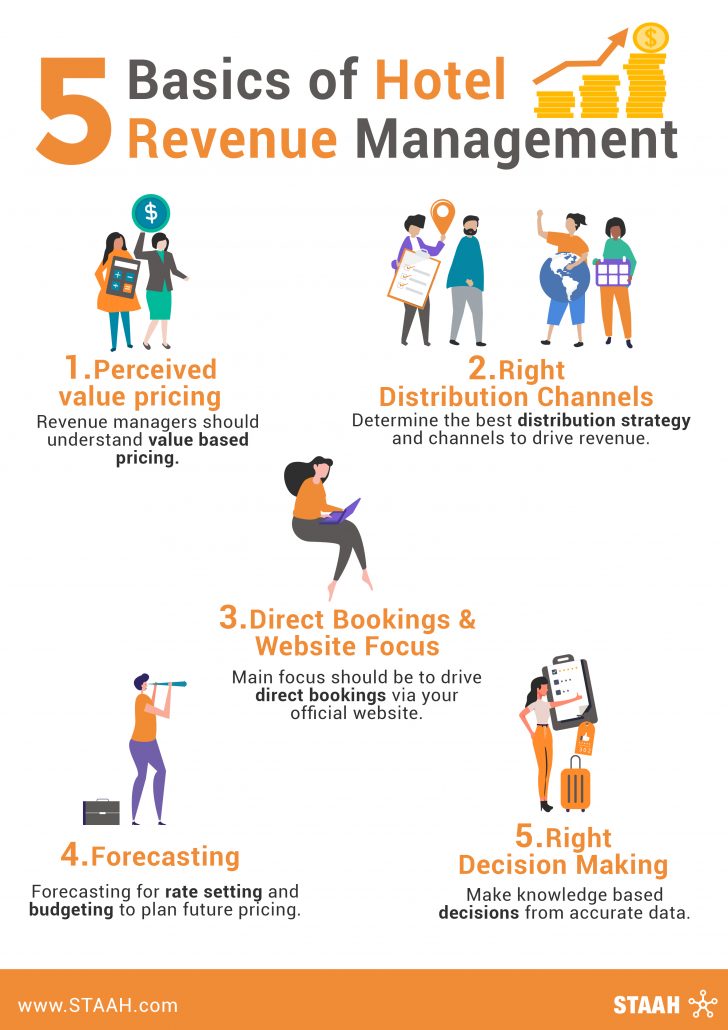
Yield Management
More bookings, higher rates, better occupancy … what do you think is top of the mind for every hotelier? Yield – how much revenue all of the above get you.
We demystify yield management – the art of maximizing revenue by selling your room to the right person, at the right time and at the right rate. It involves understanding, anticipating and influencing guest behaviour to maximise the profits for your property.
Historically used by the airline industry, yield management made its way into the hospitality industry in the 70s. The old day yield managers have evolved into revenue managers.
Revenue management vs. yield management: what’s the difference?
While there are many similarities, revenue and yield management are two distinct concepts. Yield management is narrower in scope, focusing on selling price and volume of sales with the object of maximising revenue (price optimisation). Revenue management is broader in scope, including the overall strategy and in-depth analysis and forecasting.
Read more about yield management and strategies here
Revenue Thieves: common revenue management mistakes to Avoid
Are group bookings always the right way to make money? Surprisingly, no. Especially post COVID-19 and with the travel restrictions, you have to target new segments.
Spoilage
This probably should be listed as the number one revenue thief. Spoilage includes no-shows, late cancellations and very late release of group room blocks or unsold allotment space. Essentially, this includes any scenario where we were sold out at a particular point in time and then finished with rooms available. Generally, these rooms are released back into the market as distressed inventory, but we may have potentially missed many key booking windows for a business that would have booked and stayed if the rooms were available at the time.
High Yield Spill
This occurs when we accept too many lower rates only to discover there were a lot more inquiries from customers that would have paid higher price points closer to the day, or their total piece of business would have yielded a higher value. In this situation, we have taken too many lower rates and we find ourselves in a position where we have to turn business away.
Dilution
This is where a customer accepts a price point in the market, however, they may have paid a higher price if it was still available. Dilution is difficult to measure and is more prevalent when we have no strategy around discounting in place and we find ourselves operating in a very reactive way.
Additionally, if we do not apply appropriate “rate fences” (a strategy used to minimise dilution from one market segment to another) to different price points that we put in the market, this can also have a dilutionary effect.
Low Yield Spill
The reverse of high yield spill, this is where we protected for too many higher rates or higher-yielding pieces of business and then missed the lower price points that would have booked further out from the arrival date. This can often happen in times when there is a large or significant calendar event coming up.
Sub-optimal Forecasting
This includes lack of forecasting, lack of forecasting detail or having a high degree of inaccuracy in your forecast. Forecasting forms the roadmap and is an essential element of revenue management. Without a forecast, we cannot determine what price point we should have in the market at any given point in time, and if the forecast is inaccurate, we are then selling at sub-optimal price values.
Dynamic Pricing
Holding at static pricing means having one price point for every single day of the week for the entire year and/or
season. At static pricing, there is only a certain amount of market demand you will ever be able to attract, and even if
you do have some degree of dynamic pricing in place, there can be missed opportunities at the price points between
your compressions from one price tier to another. You must regularly review your price positioning, your price
compressions and your price for value relationship in the market across all of your market segments.
Article courtesy: Melissa Kalan, Founding Director of Australian Revenue Management Association (ARMA)
Now that we have talked about the basics to keep in mind about Revenue management let us help you decide what are the most profitable channels while selling your rooms especially your Booking Engine:
60% of visitors to OTAs visit your website. As a smart hotelier, would you not want to capitalise on this visit and bag a commission-free direct booking?
What makes a Booking Engine so precious?
It is common knowledge that OTAs vastly outspend hotel operators in terms of marketing activity and brand awareness. They’re out there in full force. Yet, customers will in addition to using the OTAs site, look at an individual hotels website to search for more or local information whilst making a shortlist of booking options.
If you can convert this traffic to your site into actual bookings, think of the commission you’ll save. The icing on the cake is the fact that you “own” that customer and can upsell easily. These are also the reasons why an IBE is so important in your property’s distribution kit.
Choosing a booking engine
While it is enabled via a simple URL link, a hotel booking engine is a smart application that attracts and converts lookers into bookers. How does it do this? Through smart features.
Here are a few things you need to look out for in your booking engine:
1) Security
You’re expecting guests to process their payments via this channel. Of critical importance is security. Also ensure that you’re connected to all your relevant payment gateways. It is important to ensure that these payment gateways are PCI certified as well.
2) Smart
Smart pricing, promo codes … these features should be an integral component of a good booking engine in order to drive direct bookings. Knowing your user’s location, device, etc. and dynamically delivering the right deal at the right team is a more efficient way to market your property and increase direct bookings.
3) Driven by data
Marketing today is all about understanding your audience. How do you do this? Via data. Your booking engine is a warehouse of this data. A smart booking engine not just provides you with this data, but processes it into insights so you can make informed decisions on how to capitalise on the users coming to your website and booking engine.
Article courtesy: Edwin Saldanha, A passionate hotelier, Head of Marketing and Regional Manager – Oceania for STAAH.



